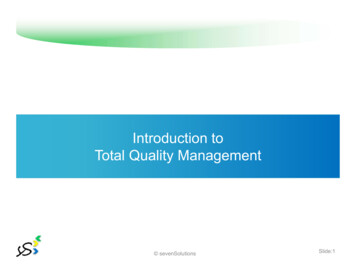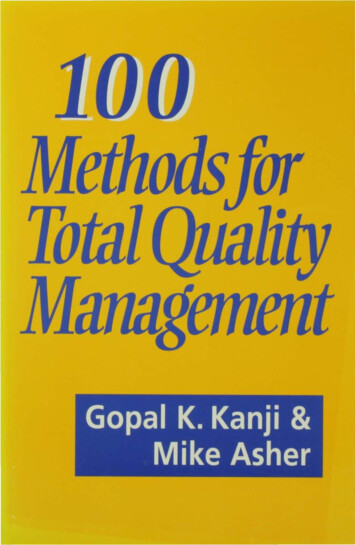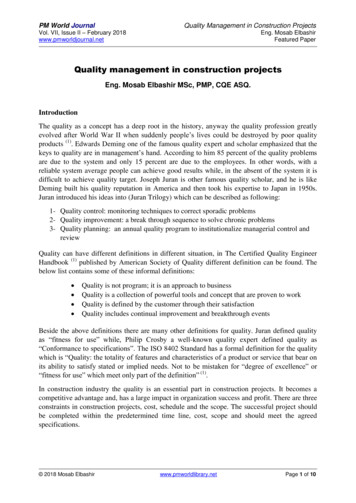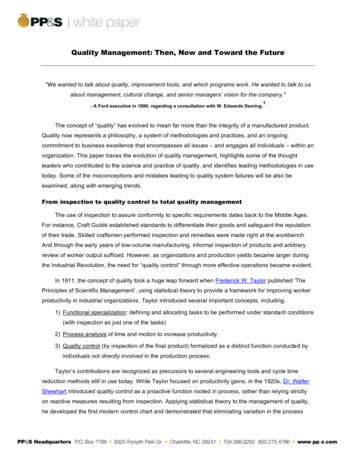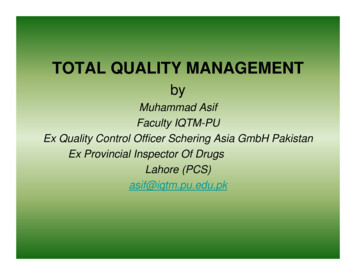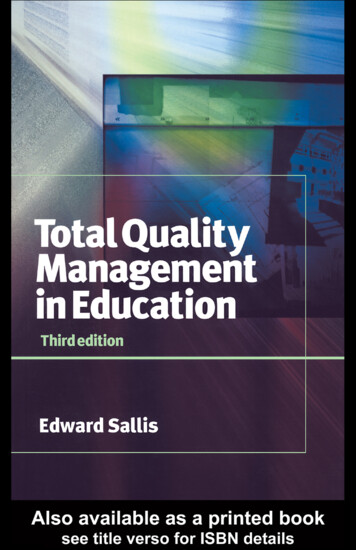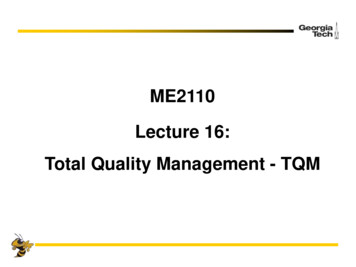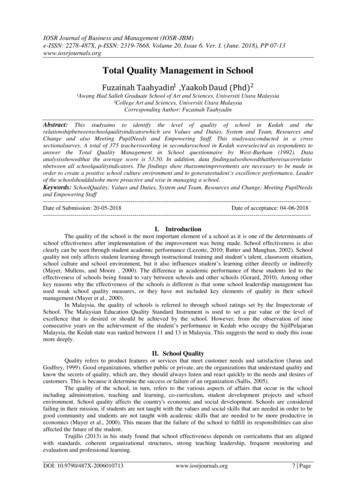
Transcription
IOSR Journal of Business and Management (IOSR-JBM)e-ISSN: 2278-487X, p-ISSN: 2319-7668. Volume 20, Issue 6. Ver. I. (June. 2018), PP 07-13www.iosrjournals.orgTotal Quality Management in SchoolFuzainah Taahyadin1 ,Yaakob Daud (Phd)2¹Awang Had Salleh Graduate School of Art and Sciences, Universiti Utara Malaysia²College Art and Sciences, Universiti Utara MalaysiaCorresponding Author: Fuzainah TaahyadinAbstract:This studyaims to identify the level of quality of school in Kedah and therelationshipbetweenschoolqualityindicatorwhich are Values and Duties, System and Team, Resources andChange and also Meeting PupilNeeds and Empowering Staff. This studywasconducted in a crosssectionalsurvey. A total of 375 teachersworking in secondaryschool in Kedah wereselected as respondents toanswer the Total Quality Management in School questionnaire by West-Burham (1992). Dataanalysisshowedthat the average score is 53.50. In addition, data findingsalsoshowedthatthereisacorrelationbetween all schoolqualityindicators. The findings show thatsomeimprovements are necessary to be made inorder to create a positive school culture environment and to generatestudent’s excellence performance. Leaderof the schoolshouldalsobe more proactive and wise in managing a school.Keywords: SchoolQuality; Values and Duties, System and Team, Resources and Change; Meeting PupilNeedsand Empowering ---------------------------------------Date of Submission: 20-05-2018Date of acceptance: ---------------------------------------------I. IntroductionThe quality of the school is the most important element of a school as it is one of the determinants ofschool effectiveness after implementation of the improvement was being made. School effectiveness is alsoclearly can be seen through student academic performance (Lezotte, 2010; Rutter and Maughan, 2002). Schoolquality not only affects student learning through instructional training and student’s talent, classroom situation,school culture and school environment, but it also influences student’s learning either directly or indirectly(Mayer, Mullens, and Moore , 2000). The difference in academic performance of these students led to theeffectiveness of schools being found to vary between schools and other schools (Gorard, 2010). Among otherkey reasons why the effectiveness of the schools is different is that some school leadership management hasused weak school quality measures, or they have not included key elements of quality in their schoolmanagement (Mayer et al., 2000).In Malaysia, the quality of schools is referred to through school ratings set by the Inspectorate ofSchool. The Malaysian Education Quality Standard Instrument is used to set a par value or the level ofexcellence that is desired or should be achieved by the school. However, from the observation of nineconsecutive years on the achievement of the student’s performance in Kedah who occupy the SijilPelajaranMalaysia, the Kedah state was ranked between 11 and 13 in Malaysia. This suggests the need to study this issuemore deeply.II. School QualityQuality refers to product features or services that meet customer needs and satisfaction (Juran andGodfrey, 1999). Good organizations, whether public or private, are the organizations that understand quality andknow the secrets of quality, which are, they should always listen and react quickly to the needs and desires ofcustomers. This is because it determine the success or failure of an organization (Sallis, 2005).The quality of the school, in turn, refers to the various aspects of affairs that occur in the schoolincluding administration, teaching and learning, co-curriculum, student development projects and schoolenvironment. School quality affects the country's economic and social development. Schools are consideredfailing in their mission, if students are not taught with the values and social skills that are needed in order to begood community and students are not taught with academic skills that are needed to be more productive ineconomics (Mayer et al., 2000). This means that the failure of the school to fulfill its responsibilities can alsoaffected the future of the student.Trujillo (2013) in his study found that school effectiveness depends on curriculums that are alignedwith standards, coherent organizational structures, strong teaching leadership, frequent monitoring andevaluation and professional learning.DOI: 10.9790/487X-2006010713www.iosrjournals.org7 Page
Total Quality Management in SchoolValues and duties (values and duties)Kent and Terrence (2002) state that values are a set of quality standards to be defined as a very goodlevel. Whereas Harcourt, Area, and State (2016) state that in carrying out their duties, the teacher's preparation isa process in the education system. It is a process to make teachers skillful, efficient and effective in classes andschools, thus equipping them as a professional teacher. Holliman (2015) states that teachers that are present atschool have strong values and beliefs to set a set of norms of their commitment to work in order to benefit theschool and its students. Meanwhile, Erdemli (2015) found that there was a significant negative relationshipbetween physical and psychological behavior with task-oriented sub-dimensions. In addition, Mohammadtaheri(2011) notes that the results of his study showed that economic factors, human relationships, school factors,teacher knowledge, value systems and personality traits are linked to teacher’s work commitments.Systems and teams (systems and teams)Collaborative school culture and professional relationships are not just coincidental. On the contrary, itneeds to be nurtured and preserved. School leadership need to be wise in assigning the job so that there is apositive teamwork culture in school. Ejionueme (2015) stated that teamwork applications allow teachers to sharetheir ideas and knowledge and teamwork also motivates staff to stay in touch with each other. Indirectly, thisproves that teamwork is essential for quality management in schools and teams can be established tocommunicate more effectively in school administration. Meanwhile, Quintero (2017) stated that studentperformance improved dramatically as teachers had a good teamwork. While Mulford (2003) states that thesystem established by the school leadership should be balanced with learning so that it is well received by itsschool team. In addition, Schochet and Chiang (2010) in his study stressed that the teacher performancemeasurement system needs to be carefully considered by policymakers. They further suggest that the addedvalue in teacher performance measurement is held so that it can provide an edge in measuring teacher quality.Resources and changesWang, Walters, and Thum (2013) in his study suggested the importance of using the value-added orprogress of the student's learning as a complementary measure of school success, especially to make a majorpolicy decision for a school. This is in line with the findings of Zmuda, Kuklis, and Kline (2004) stated thatsystemic support to policies, structures and resources can sustain continuous focus on goals and decisionsagreed upon by an organization. And it highlights the long-term nature of the process of education change.While Holliman (2015) finds that teachers with high performance and commitment have the ability to innovateand this can influence students' attitudes and attitudes towards school despite limited resources.Meeting students' needs and empowered staffSallis (2005) states that quality is about fulfilling and exceeding customer needs and desires. Thismeans that at school it is important to make the wishes and desires of the students and management clearer. Thisis in line with West-Burnham and Bradbury (2003) which stipulates the needs of students and schoolmanagement to be fulfilled including determining student placement, recommending class size, determiningmethod of student progress reporting to parents, choosing counseling services, identifying students for award,and help solving students' academic and personal problems. Similarly with Dorsey (1999) stating that employeesneed to understand how they and their students will benefit from changes to customer focus. The combination ofprofessionalism with the best quality is essential to achieve success in a school. While Tetzloff (1996) states thatteachers need to use appropriate teaching strategies to meet the needs of students.III. Research objectivesThe main objectives of this study are to identify:1) The quality level for the secondary schools in Kedah.2) Significant relationship between Values and Duties with Systems and Teams.3) Significant relationship between Value and Duties with Resources and Change.4) Significant relationship between Value and Duties withMeeting Pupil Needs and Empowering Staff5) A significant relationship between System and the Team with the Resources and Change.6) Significant relationships between System and the Team with Meeting Pupil Needs and Empowering Staff7) Significantrelationship between Resources and changewithMeeting Pupil Needs and Empowering StaffResearch QuestionsBased on the objective of the study, a questionnaire was constructed:1) What is the level of quality for schools in Kedah secondary schools?2) Is there a significant relationship between Value and Duties with Systems and Teams?3) Is there a significant relationship between Value and Tasks with Resources and Change?DOI: 10.9790/487X-2006010713www.iosrjournals.org8 Page
Total Quality Management in School4) Is there a significant relationship between Values and Tasks withMeeting Pupil Needs and EmpoweringStaff?5) Is there a significant relationship between the System and the Team with the Resources and Change?6) Is there a significant relationship between the System and the Team withMeeting Pupil Needs andEmpowering7) Staff?8) Is there a significant relationship between the Resources and changewithMeeting Pupil Needs andEmpowering Staff?IV. Research HypothesesThere are six null hypotheses that will be tested in this study. Question 1 in the study question is not presentedin the hypothesis because the question of this study is more on descriptive analysis questions that explain thenext hypothesis.Hypothesis 1: There is a significant positive relationship between Values and Duties with Systems and Teams.Hypothesis 2: There is a significant positive relationship between Values and Duties with Resources andChange.Hypothesis 3: There is a significant positive relationship between Values and Duties by Meeting Pupil Needsand Empowering StaffHypothesis 4: There is a significant positive relationship between the System and the Team with theResourcesand Change.Hypothesis 5: There is a significant positive relationship between the System and the Team by MeetingPupilNeeds and Empowering StaffHypothesis 6: There is a significant positive relationship between the Resourcesand Change withMeeting PupilNeeds and Empowering StaffV. MethodologySampleThis study involved 375 teachers that are currently serving in Kedah secondary school. The selection ofteachers is based on the criteria of the school (i) regular daily secondary school; (ii) school capacity of at least100 teachers; (iii) schools that are below Band 3 in Malaysia Education Quality Standards. Respondents wereselected from eight schools according to the local districts of Kedah.Design and Research InstrumentThe study was carried out on a cross-sliced survey. Data quotes are quantitatively. This study uses theTotal Quality Management in School (West-Burham, 1992) questionnaire. This instrument was chosen toidentify teachers' perceptions towards quality management in schools. This instrument contains 15 items whichrefer to 4 breakdown of indicators which are; i) values and duties; ii) Systems and teams; iii) Resources andchanges and; iv) Meeting students' needs and empowered staff. This instrument uses five options based onLikert Scale.VI. FindingsTable 1 shows that almost three quarters or 71.5% of respondents are women. While in terms of age,the majority is 38.9% are older than 46 - 55 years old. In terms of education, 87.2% of respondents haveBachelor Degree education level. In terms of services, 72.3% of respondents have been serving more than 10years and 39.5% of respondents have been in school for more than 10 years.Table 1 :Respondent Demographic FactorSexMaleFemaleAge CategoryBelow than 2526 – 3536 – 4546 – 55More than 55Academic QualificationsSPMSTPMDiplomaDegreeMasterDOI: 0.500.8087.2010.40www.iosrjournals.org9 Page
Total Quality Management in SchoolPhDTeaching ExperienceBelow than 1year1–56 – 10More than 10 yearsTeaching Experience In Current SchoolBelow than 1 year1–56 – 10More than 10 1033.9039.50Table 2 shows data findings for the mean of the school's overall score is 53.50, mode is 45.00, standarddeviation is 7.61, interval is 41.00, minimum score is 34.00 and maximum score is 75.00.Table 2 :Mean, Mode, Standard Deviation, Range, Maximum and Minimum of School Quality for SecondarySchools in MaximumSchool Quality53.5045.007.6141.0034.0075.00The next study is further subdivided according to the breakdown of school quality indicators. The fourindicators for the quality of the school studied are Values and Duties, Systems and Teams, Resources andChanges, and Meeting Students' Needs and Empowered Staff.Table 3 shows the findings of data for indicators under the quality of the school. For the values anddutie indicators, the mean is 11.68 and the standard deviation is 1.96. Next system and teams indicator, mean is13.84 and standard deviation is 2.44. While for resource and change indicator, mean is 14.24 and standarddeviation is 2.71. For indicators meeting students' needs and empowered staff, data findings indicate mean is13.75 and the standard deviation is 2.67.Table 3 :Mean and Standard Deviation of School Quality Indicator for Secondary Schools in KedahVariableValues and dutiesSystems and teamsResources and changeMeeting students’ needs and empowered staffMean11.6813.8414.2513.75Standard Deviation1.962.442.712.67Table 4 shows the details of the indicators according to the school's quality study questions. For theValue and Task indicators, majority of respondents stated that they are responsible for quality. Similarly, theirschool administrators who are personally found to be committed to quality. They also find the value and missionof their school is clear and detailed.While for the System and Team indicators, majority of respondents stated that the system in theirschools had been adjusted to school attendees. Meanwhile, the emphasis in their schools is on prevention. Apartfrom that, they also found that free from mistakes was a good quality. Other than that, they also did work inteams.For indicators of Resources and Changes, majority of respondents believed that special training is theonly way to improve and change is the natural process in education. For them, being the best is not by havingmore resources and they feel they can improve to be better.Next for the Meeting Students' Needs and Empowered Staff, the majority of respondents stated thatthey met their customers 'needs and they listened to their customers' needs. Same goes to with their schoolleadership who always listen and think. Accordingly, they beleived that the staff should be empowered.Table 4 :Mean and Standard Deviation of School Quality by Questions for Secondary Schools in KedahValues and dutiesS1Quality is outside our control.The head abdicates responsibilityS2for quality.Values and mission are vague tionWe are all responsible for quality.The head is personally committedto quality.Values and mission are explicitand lived.4.070.883.501.174.090.85Systems fit people.3.221.12Systems and TeamsS3People fit into systems.DOI: 10.9790/487X-2006010713www.iosrjournals.org10 Page
Total Quality Management in SchoolS4The emphasis is on detection.S11Mistakes are inevitable.S12Work is done by individuals.Resources and ChangeTraining gets in the way of theS6real 452345There is too much change.Improving quality means moreS131resources.S15We are a good school.1Meeting students’ needs and empowered staffS8We teach students.1S9We give out information.1School leadership administerS101systems.S14Staff have to be controlled1The emphasis is on prevention.Error free is the only standard.Work is done through teams.Training is the only way toimprove.Change is the natural process ofeducation.Better does not mean moreresources.We can and must improve.We meet customer needs.We listen to our customers.School leadership listenthink.Staff must be Table 5 describes the correlation relationship between school quality indicators. Pearson's Correlation Analysishas been used to recognize whether there is a relationship between Values and Tasks, Systems and Teams,Resources and Changes and Meeting Students' Needs and Empowered Staff.Hypothesis 1: Accepted because there was a significant positive relationship between VD and ST (r 0.496, p 0.01).Hypothesis 2: Accepted because there was a significant positive relationship between VD and RC (r 0.451, p 0.01)Hypothesis 3: Accepted because there was a significant positive relationship between VD and MS (r 0.332, p 0.01)Hypothesis 4: Accepted because there was a significant positive relationship between ST and RC (r 0.600, p 0.01)Hypothesis 5: Accepted because there was a significant positive relationship between ST and MS (r 0.481, p 0.01)Hypothesis 6: Accepted because there is a significant positive relationship between RC and MS (r 0.446, p 0.01)Table 5 :Relationship between Values and Tasks, Systems and Teams, Resources and Changes and Meetingstudents’ needs and empowered C.45**1.45**.33**MS.60**.48**.45**1**. r is significant at *p 0.05 **p 0.01 Sig. (2-tailed)Keywords:VD: Values and dutiesST: Systems and teamsRC: Resources and changeMS: Meeting students’ needs and empowered staffVII.DiscussionThe findings of this study show that the quality level of traditional daily schools in Kedah is moderate.This decision is in line with the findings of the Inspectorate and Quality Assurance because the school studied israted more than the band 3. In addition, the findings also support all hypotheses where there is a positiverelationship between all the quality indicators. This proves that in order to create a quality school, teachers needto understand all the elements that are available in their schools and to successfully fulfill the mission set by theschool management despite the limited resources. In addition, school management should also play a proactiverole in every activity conducted at school. School leadership needs to be efficient in managing the school. Everyactivity that needs to be done should have a careful planning and in the implementation phase it is necessary tomonitor the sensitivity of the school management itself. Not only that, the effectiveness of the activityevaluation process should be carried out after an activity is successfully implemented to review the relevance ofthe activity and to track the improvements that should be made to each activity implemented. Positivecollaboration between school management and teachers needs to be created because the quality is alsoDOI: 10.9790/487X-2006010713www.iosrjournals.org11 Page
Total Quality Management in Schoolinterpreted as a result of the actions and decisions by the top management and not just the result of the workdone by the workers (Deming, 1981).Systems and Teams are found to have a strong relationship with Resources and Changes and positivelyalso have relationships with Values and Tasks Meeting Pupil Needs and Empowering Staff. To improve thequality of the school, the school leadership needs to create a solid, committed and productive work group thatcan develop teamwork and teamwork culture (Karakus and Aslan, 2009).Values and Tasks are found to have link with Resources and Changes and meet the Student and SchoolManagement requirements. Tasks in school will be more complicated and severe if a school is classified asineffective school and has non-functioning members (Reynolds and Teddlie, 2001). Therefore, a positive workculture should be created as it is the key to the success of a school (Mitchell, 2008).The resources and changes are found to have relationship with Meet the Student's Will and SchoolManagement. Inuwa and Yusof (2013) stated that apart from meeting the needs of student teaching and learningfacilities, the safety aspect at school is also important. Schools should always make changes that are appropriateto current needs.ReferencesJournal 11].[12].[13].[14].[15].[16].[17].Dorsey, P. A. (1999). JudmentsOf Elementary School Improvement Team Members And Non-School Improvement Team MembersAbout Involvement In Decision And Principals Instuctional Leadership In High-And Low-Performing Schools.Ejionueme, L. K. (2015). Application of Total Quality Management ( TQM ) in Secondary School Administration in UmuahiaEducation Zone. Journal of Education and Practice, 6(27), 102–112.Harcourt, P., Area, L. G., dan State, R. (2016). Managing Teacher Preparation for Curriculum Execution and School Improvementin Rivers State, 7(20), 145–151.Holliman, A. B. H. dan S. L. (2015). Urban Teacher Commtiment: Exploring Associations With Organizational Conflict, SupportFor Innovation, and Partipation, 160–180.Inuwa, A. M., danYusof, N. M. (2013). Parents and Students Perspectives of School Culture Effects on Dropouts and Non-dropoutsin Sokoto Metropolis Nigeria. Research on Humanities and Social Sciences, 3(18), 89–97.Kent, D., dan Terrence, E. (2002). The Shaping School Culture Fieldbook. Mitchell, B. D. (2008). a Quantitative Study on PositiveSchool Culture and Student. University of Phoenix.Mulford, B. (2003). OECD Commissioned Paper School Leaders : Challenging Roles And Impact On Teacher And SchoolEffectiveness, (April).Reynolds, D., danTeddlie, C. (2001). Reflections On The Critics and Beyond Them. School Effectiveness and School Improvement,12(1), 99–113.Harcourt, P., Area, L. G., dan State, R. (2016). Managing Teacher Preparation for Curriculum Execution and School Improvementin Rivers State, 7(20), 145–151.Holliman, A. B. H. dan S. L. (2015). Urban Teacher Commtiment: Exploring Associations With Organizational Conflict, SupportFor Innovation, and Partipation, 160–180.Inuwa, A. M., danYusof, N. M. (2013). Parents and Students Perspectives of School Culture Effects on Dropouts and Non-dropoutsin Sokoto Metropolis Nigeria. Research on Humanities and Social Sciences, 3(18), 89–97.Kent, D., dan Terrence, E. (2002). The Shaping School Culture Fieldbook.Mitchell, B. D. (2008). a Quantitative Study on Positive School Culture and Student. University of Phoenix.Mulford, B. (2003). OECD Commissioned Paper School Leaders : Challenging Roles And Impact On Teacher And SchoolEffectiveness, (April).Reynolds, D., danTeddlie, C. (2001). Reflections On The Critics and Beyond Them. School Effectiveness and School Improvement,12(1), 99–113.West-Burnham, J., dan Bradbury, I. (2003). Performance Management Manual : Creating a Culture For Sustainable HighPerformance.Zmuda, A., Kuklis, R., dan Kline, E. (2004). Transforming Schools : Creating A Culture Of Continuous Improvement. VirginiaUSA.Books[18]. Fah, L. Y., danHoon, K. C. (2009). PengenalanKepadaAnalisis Data Komputerdengan SPSS 16.0 for Windows (1st Editon).Malaysia: Venton Publishing (M) Sdn. Bhd.[19]. Idris, N. (2010). PenyelidikanDalamPendidikan. Malaysia: Mc Graw Hill Education.[20]. Merriam, S. B. (2009). Qualitative Research : A Guide to Design and Implementation (Second Edi). United States of America:Jossey-Bass.[21]. Sallis, E. (2005). Total Quality Management in Education (Third Edition). London: Taylor dan Francis e-Library.[22]. Zmuda, A., Kuklis, R., dan Kline, E. (2004). Transforming Schools : Creating A Culture Of Continuous Improvement. VirginiaUSA.Journal Articles with DOI[23]. Erdemli, Ö. (2015). Teachers’ Withdrawal Behaviors and their Relationship with Work Ethic. Eurasian Journal of EducationalResearch, 15(60), 201–220. http://doi.org/10.14689/ejer.2015.60.12[24]. Karakus, M., dan Aslan, B. (2009). Teachers’ commitment focuses: a three-dimensioned view. Journal of ManagementDevelopment, 28, 425–438. http://doi.org/10.1108/02621710910955967[25]. Mohammadtaheri, N. (2011). The study of effective factors on the teachers’ work commitment in High Schools. Procedia - Socialand Behavioral Sciences, 29(Iceepsy), 1524–1530. http://doi.org/10.1016/j.sbspro.2011.11.393[26]. Schochet, P. Z., dan Chiang, H. S. (2010). Error Rates in Measuring Teacher and School Performance Based on Student Test ScoreGains. National CenterFor Education Evaluation and Regional Assistance, 65. http://doi.org/10.1037/e598792011-001[27]. Trujillo, T. (2013). The reincarnation of the effective schools research: rethinking the literature on district effectiveness. Journal ofEducational Administration, 51(4), 426–452. http://doi.org/10.1108/09578231311325640DOI: 10.9790/487X-2006010713www.iosrjournals.org12 Page
Total Quality Management in School[28].Wang, A. H., Walters, A. M., danThum, Y. M. (2013). Identifying highly effective urban schools: comparing two measures ofschool success. International Journal of Educational Management, 27, 517–540. http://doi.org/10.1108/09513541311329878Journal Articles without DOI[29]. Quintero, E. (2017). Elevating relationships. How Collaboration Shapes Teaching and Learning. American Educator, Summer, 18–21. Retrieved from blished thesis[30]. Tetzloff, P. J. (1996). Impact Of School Culture On Effective Middle Level Schools’ Planned Change Efforts. University OfMinnesota.IOSR Journal of Business and Management (IOSR-JBM) is UGC approved Journal with Sl.No. 4481, Journal no. 46879.〖Fuzainah Taahyadin〗 "Total Quality Management in School” .IOSR Journal of Business andManagement (IOSR-JBM) 20.6 (2018): 07-13.DOI: 10.9790/487X-2006010713www.iosrjournals.org13 Page
Total Quality Management in School Fuzainah Taahyadin1,Yaakob Daud (Phd)2 ¹Awang Had Salleh Graduate School of Art and Sciences, Universiti Utara Malaysia ²College Art and Sciences, Universiti Utara Malaysia Corresponding Author: Fuzainah Taahyadin Abstract: This studyaims to identify the lev
